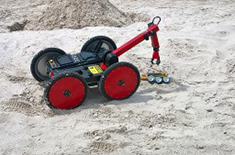RoboUtes Placed Third in National Competition
May 31, 2016

Like the proverbial Phoenix rising from the ashes, the University of Utah’s RoboUtes student robotic team emerged from a crippling lab fire last year to place third in the 2016 RASC-AL Robo-Ops robotic competition in Houston, Texas.
“Not having a central home for the team made it very difficult to have the team meet and be cohesive,” said the team’s advisor, U mechanical engineering associate professor Mark Minor. “But the core of the team really made this happen. I’m really proud of what they did.”
This year’s five-person team, made up of students from the U’s mechanical engineering and School of Computing departments, placed third in the competition, held at NASA’s Johnson Space Center May 24 through 26. Eight teams were invited to compete out of 28 applicants. The University of Oklahoma’s team took first place while West Virginia University was second.
In the competition, sponsored by NASA, students design and build robots that must operate in arenas that simulate both lunar and Martian surfaces. The machines must navigate through craters, hills and obstacles, pick up scientific samples and perform other missions including rescuing another robot.
The RoboUtes’ robot, dubbed COAL VII, is about 2½ by 2½ feet, weighs about 68 pounds, and has a three-fingered claw to pick up samples. During the competition, it was remotely operated from the U’s new Utah Robotics Center lab in the Rio Tinto Kennecott Mechanical Engineering Building.
A battery-caused fire last August in the team’s Rio Tinto building lab destroyed one of its early robots, forcing the students to scramble for temporary meeting space. No injuries were reported in the fire.
This is the second robotics contest in May in which the University of Utah performed well. The Utah Robotic Mining Project — another robotics team comprised of 14 members from the U’s departments of mechanical engineering, electrical and computer engineering, geology, mining engineering and computer engineering — took third place overall and won the Innovation Award at the NASA Robotic Mining Competition in Cape Canaveral, Florida. That competition was held May 18 through 20 and involved student-built robots that had to scoop up ice on a simulated Martian field. Forty-five schools competed in that contest.